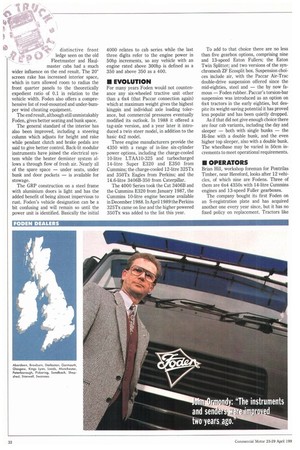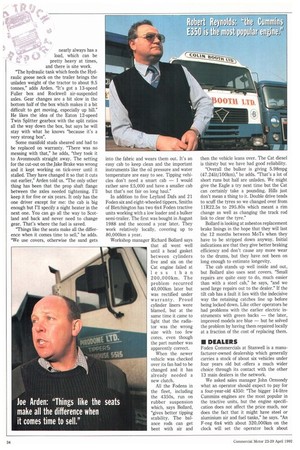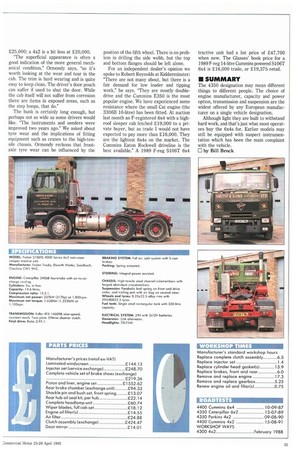• In October 1980 Foden was a "traditional" British truck
Page 32

Page 34

Page 35

Page 36

Page 37

If you've noticed an error in this article please click here to report it so we can fix it.
manufacturer with more than its share of financial problems. Then it was snapped up by the American truck giant Paccar, manufacturer of the classic Kenworth and Peterbilt marques.
Contrary to the expectation of some pessimistic pundits Foden was not condemned to becoming no more than a British manufacturing facility for American trucks or, heaven forbid, Paccar mining equipment.
Instead the Sandbach truck maker was transformed into an American-style producer of custom trucks, which today offers a wider range of proprietary parts than any other European marque.
Foden introduced its present 4000 Series cab during the summer of 1987, although research began three years earlier with advice sought from those most likely to end up buying it. Drivers, operators and engineers all had a say in what they wanted from a new cab, although at an early stage it was decided to retain the advantages derived from the existing method of manufacture. One point was overridingly clear — the overall design needed to be more aerodynamically efficient.
Moving the bottom of the windscreen forward, fundamental in eliminating the distinctive front ledge seen on the old Fleetmaster and Haulmaster cabs had a much wider influence on the end result. The 20° screen rake has increased interior space, which in turn allowed room to radius the front quarter panels to the theoretically expedient ratio of 0.1 in relation to the vehicle width. Foden also offers a comprehensive list of roof-mounted and under-bumper wind cheating equipment.
The end result, although still unmistakably Foden, gives better seating and bunk space.
The general standard of the interior has also been improved, including a steering column which adjusts for height and rake while pendant clutch and brake pedals are said to give better control. Back-lit modular instruments have joined the electrical system while the heater demister system allows a through flow of fresh air. Nearly all of the spare space — under seats, under bunk and door pockets — is available for stowage, The GRP construction on a steel frame with aluminium doors is light and has the added benefit of being almost impervious to rust. Foden's vehicle designation can be a bit confusing and will remain so until the power unit is identified. Basically the initial 4000 relates to cab series while the last three digits refer to the engine power in 50hp increments, •so any vehicle with an engine rated above 300hp is defined as a 350 and above 350 as a 400.
• EVOLUTION
For many years Foden would not countenance any six-wheeled tractive unit other than a 6x4 (that Paccar connection again) which at maximum weight gives the highest kingpin and individual axle loading tolerance, but commercial pressures eventually modified its outlook. In 1988 it offered a tag-axle version, and a year later it introduced a twin steer model, in addition to the basic 4x2 model.
Three engine manufacturers provide the 4350 with a range of in-line six-cylinder power options, including the charge-cooled 10-litre LTAA10-325 and turbocharged 14-litre Super E320 and E350 from Cummins; the charge-cooled 12-litre 325Tx and 350Tx Eagles from Perkins; and the 14.6-litre 3406B-350 from Caterpillar.
The 4000 Series took the Cat 3406B and the Cummins E320 from January 1987, the Cummins 10-litre engine became available in December 1988. In April 1989 the Perkins 325Tx came on line and the higher powered 350Tx was added to the list this year.
To add to that choice there are no less than five gearbox options, comprising nine and 13-speed Eaton Fullers; the Eaton Twin Splitter; and two versions of the synchromesh ZF Ecosplit box. Suspension choices include air, with the Paccar Air-Trac double-drive suspension offered since the mid-eighties, steel and — the by now famous — Foden rubber. Paccar's torsion-bar suspension was introduced as an option on 6x4 tractors in the early eighties, but despite its weight-saving potential it has proved less popular and has been quietly dropped.
As if that did not give enough choice there are four cab variants, including the day and sleeper — both with single bunks — the Hi-line with a double bunk, and the even higher top sleeper, also with a double bunk. The wheelbase may be varied in 50cm increments to meet operational requirements.
• OPERATORS
Brian Hill, workshop foreman for Pontrilas Timber, near Hereford, looks after 12 vehicles, of which nine are Fodens. Three of them are 6x4 4350s with 14-litre Cummins engines and 13-speed Fuller gearboxes.
The company bought its first Foden on an S-registration plate and has acquired another one every year since, but it has no fixed policy on replacement. Tractors like the 4350 are used initially as frontline vehicles delivering prepared timber all over the UK.
With a flat trailer they have an impressive 25-tonne payload and return about 38.71it/100km (7.3mpg) covering about 100,000km a year, mostly fully laden only on the outward trip.
After a few years they are equipped with a chassis-mounted crane and put to work hauling timber out of the woods on pole carriers. It is during this part of a vehicle's life that the double-drive with cross-axle and inter-axle difflocks, and the high-tensile chassis, show their worth.
"The local dealer offers a 24-hour service but if you don't push them they can be a bit slow with anything that's not in stock," he adds. "We have our own stock of parts because we only get discount if we can get it off the shelf."
Fortunately Hill does not expect many problems outside of regular servicing. The synchro hubs in the back of one of the Fuller gearboxes wore and prevented gear selection, but the major fault was with electric gauges which gave incorrect readings and had to be replaced. But generally they are strong and built to last: "That's why Pontilas bought them," says Hill.
Joe Arden of Pirodome Haulage has run a fleet of tippers and construction plant from premises in Stroud since 1974. Now he has 20 Leyland Daf six-wheelers: "I was lucky — I must have seen the recession coming before most people and reduced the size of the fleet when you could still sell trucks," he says.
He bought his F-reg 6x4 Foden 4350 new to operate with a low loader: "I wanted to buy British but the delivery on an ERF was too long," he told us. "I have had some experience of the Cat engine in plant equipment and think it is the best choice in the Foden 4000 — it will be easy to sell. We get about 6.3mpg (44.81it/100km) which I am well satisfied with when you consider it nearly always has a load, which can be pretty heavy at times, and there is site work.
"The hydraulic tank which feeds the Hydraulic goose neck on the trailer brings the unladen weight of the tractor to about 9.5 tonnes," adds Arden. "It's got a 13-speed Fuller box and Rockwell air-suspended axles. Gear changes are a bit slow in the bottom half of the box which makes it a bit difficult to get moving, especially up hill." He likes the idea of the Eaton 12-speed Twin Splitter gearbox with the split ratios all the way down the box, but says he will stay with what he knows "because it's a very strong box".
Some manifold studs sheared and had to be replaced on warranty. "There was no messing with that," he adds, "they took it to Avonmouth straight away. The setting for the cut-out on the Jake Brake was wrong and it kept working on tick-over until it stalled. They have changed it so that it cuts out earlier,' Arden told us. "The only other thing has been that the prop shaft flange between the axles needed tightening. I'll keep it for five or six years, It only has the one driver except for me: the cab is big enough but I'll specify a night heater in the next one. You can go all the way to Scotland and back and never need to change gear. That's where the fuel is saved.
`Things like the seats make all the difference when it comes time to sell," he adds. "We use covers, otherwise the sand gets
into the fabric and wears them out. It's an easy cab to keep clean and the important instruments like the oil pressure and water temperature are easy to see. Tipping vehicles don't need a smart cab — I would rather save £5,000 and have a smaller cab but that's not fair on long haul."
In addition to five Leyland Dafs and 21 Foden six and eight-wheeled tippers, Smiths of Bletchington has two 6x4 Foden tractive units working with a low loader and a bulker semi-trailer. The first was bought in August 1988 and the second a year later. They work relatively locally, covering up to 80,000km a year.
Workshop manager Richard Bollard says that all went well until a head gasket between cylinders five and six on the Cat engine failed at less than 200,000km. The problem recurred 40,000km later but was rectified under warranty. Proud cylinder liners were blamed, but at the same time it came to light that the radiator was the wrong size with too few cores, even though the part number was apparently correct.
When the newer vehicle was checked over its fan had to be changed and it has already needed a new clutch.
All the Fodens in the fleet, including the 4350s, run on rubber suspension which, says Bollard, "gives better tipping stability. The balance rods can get bent with air and then the vehicle leans over. The Cat diesel is thirsty but we have had good reliability.
"Overall the bulker is giving 5.98mpg (47.241k/1001=)," he adds. "That's a lot of short runs but half are unladen. We might give the Eagle a try next time but the Cat can certainly take a pounding. Hills just don't mean a thing to it. Double drive tends to scuff the tyres so we changed over from 11R22.5s to 295.80s which meant a rim change as well as changing the track rod link to clear the tyre."
Bollard is looking at asbestos replacement brake linings in the hope that they will last the 12 months between MoTs when they have to be stripped down anyway. Initial indications are that they give better braking efficiency and don't cause any more wear to the drums, but they have not been on long enough to estimate longevity.
The cab stands up well inside and out, but Bollard also uses seat covers. 'Small repairs are quite easy to do, much easier than with a steel cab," he says, "and we send large repairs out to the dealer," If the tilt cab has a fault it lies with the indecisive way the retaining catches line up before being locked down. Like other operators he had problems with the earlier electric instruments with green backs — the later, improved models are blue — but he solved the problem by having them repaired locally at a fraction of the cost of replacing them.
• DEALERS
Foden Commercials at Stanwell is a manufacturer-owned dealership which generally carries a stock of about six vehicles under four years old but .offers a much wider choice through its contact with the other 13 main dealers in the network.
We asked sales manager John Ormondy what an operator should expect to pay for a four-year-old 4350: 'The bigger 14-litre Cummins engines are the most popular in the tractive units, but the engine specification does not affect the price much, nor does the fact that it might have steel or aluminium air and fuel tanks," he says. "An F-reg 6x4 with about 320,000km on the clock will set the operator back about £25,000; a 4x2 is a bit less at £20,000.
"The superficial appearance is often a good indication of the more general mechanical condition," Ormondy says, "so it's worth looking at the wear and tear in the cab. The trim is hard wearing and is quite easy to keep clean. The driver's door pouch can suffer if used to shut the door. While the cab itself will not suffer from corrosion there are items in exposed areas, such as the step hoops, that do."
The bunk is certainly long enough, but perhaps not as wide as some drivers would like. "The instruments and senders were improved two years ago." We asked about tyre wear and the implications of fitting equipment such as cranes to the high-tensile chassis. Ormondy reckons that frontaxle tyre wear can be influenced by the position of the fifth wheel. There is no problem in drilling the side webb, but the top and bottom flanges should be left alone.
For an independent dealer's opinion we spoke to Robert Reynolds at Kidderminster: "There are not many about, but there is a fair demand for low loader and tipping work," he says. "They are mostly doubledrive and the Cummins E350 is the most popular engine. We have experienced some resistance where the small Cat engine (the 3306B 10-litre) has been fitted. At auction last month an F-registered 6x4 with a highroof sleeper cab fetched £19,000 to a private buyer, but as trade I would not have expected to pay more than £16,000. They are the lightest 6x4s on the market. The Cummins Eaton Rockwell driveline is the best available." A 1989 F-reg 5106T 6x4 tractive unit had a List price of £47,700 when new. The Glasses' book price for a 1989 F-reg 14-litre Cummins powered S106T 6x4 is £16,000 trade, or £19,375 retail.
• SUMMARY
The 4350 designation may mean different things to different people. The choice of engine manufacturer, capacity and power option, transmission and suspension are the widest offered by any European manufacturer on a single vehicle designation.
Although light they are built to withstand hard work, and that's just what most operators buy the 6x4s for. Earlier models may still be equipped with suspect instrumentation which has been the main complaint with the vehicle.
0 by Bill Brock
















































































